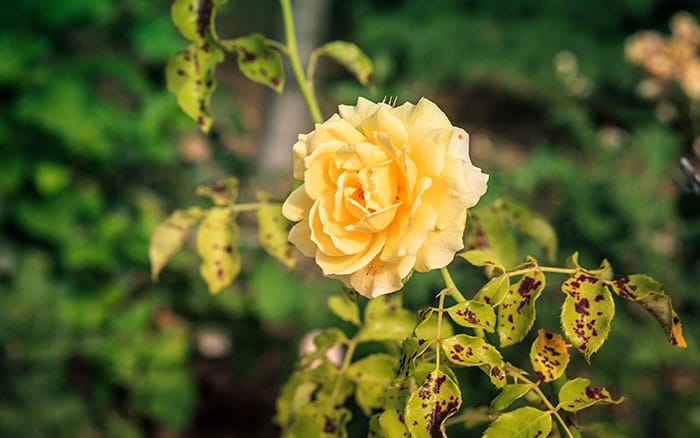The rose is England’s national flower and much loved throughout the U.K. and rest of the world but sadly they can be badly affected by a persistent disease called black spot. Read my guide to find out more about black spot on roses.
What is black spot on roses?
Black spot, or Diplocarpon rosae is a very common fungal disease which can affect most types of roses. The fungus infects the leaves and can weaken the plant’s growth.
It can be spotted when large, dark brown-purple-black spots or blotches with irregular edges appear on the upper side of the plant’s leaves.
Many disease-affected leaves turn yellow before dropping from the plant whilst it’s still in active growth.
These symptoms usually appear on rose plants from late spring and through to autumn when the plants become dormant.

How to control black spot
There is no cure for black spot on roses. However, there are several things you can do to minimise the effects and avoid plants succumbing to it in the first place.
- When buying a new rose plant, choose plants that are said to be resistant to black spot.
- Pick off infected leaves when first seen in the spring to help minimise their spread. Do this only if you’ve had a definite diagnosis that the blotches are black spot. This is because removing leaves can limit the plant’s ability to grow well.
- Pruning existing roses hard in the spring could help as this removes shoots where the disease spores may have been overwintering.
- Pick up and remove diseased leaves from the soil surface.
- Apply a deep layer of mulch around the plant before and after pruning to bury any infected leaves that may have escaped your notice.
- Avoid overcrowding around rose plants to allow air to circulate around them.
- Try to water in the morning so leaves will hopefully dry out quicker than if watered in the afternoon or early evening.
- Give the plants regular foliar feeds of which there are several brands available. Spray the whole plant.
None of these will ‘cure’ the problem, but together can help minimise the effects.


Leave A Comment